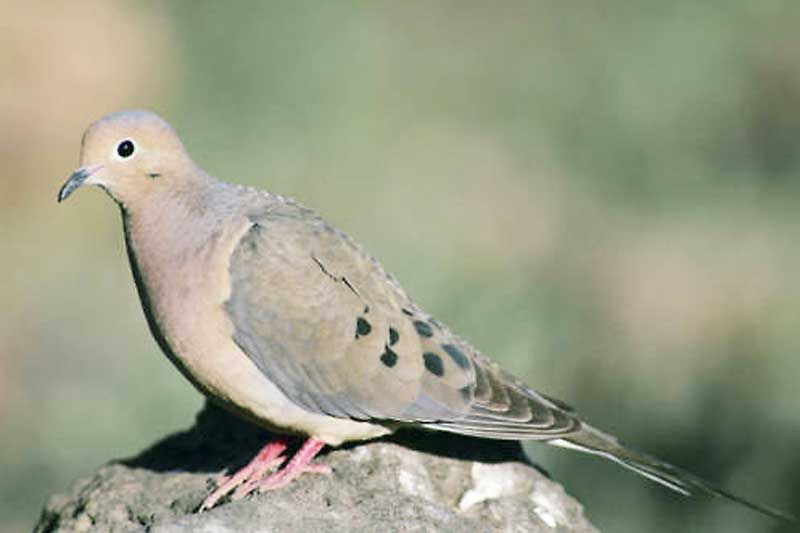Lorraine Julien | Apr 07, 2016
The Mourning Dove is easily recognizable with its long, plump, medium-sized body and undersized head. They are an interesting and intelligent bird and are sometimes called Turtle Doves. The body is a grayish light brown colour with a very pale, rosy breast and black spots on its folded wings. The brown colouring on the feathers makes a perfect camouflage, especially on bare ground.
A couple of dozen birds huddled together near our home during most evenings this past winter. Their favourite spot at night was some bare ground under our lilac bush, which was not too far from the bird feeder and where they were protected from strong winds and some predators by the board fence. It wasn’t until I used binoculars that I could identify the brown lumps as birds.
Although the Mourning Dove does have a mournful call, it is much more prevalent once another breeding season starts and the birds stake out a territory to attract a mate and raise their young. Doves are very fast flyers, using powerful wing beats with their long, pointed tail stretching out behind them. The wings make a whistling noise as they take off. They are usually found on hydro wires or in fields or patches of bare ground where they love to forage for seeds and insects. The method of scratching and looking for seeds reminds me of free-range chickens on a farm. About the only place you won’t find Mourning Doves is in thick forest.
The nest is a flimsy structure – little more than a haphazard pile of twigs perched precariously on a branch – usually in an evergreen tree close to the trunk. The base of the nest is so loosely built that the eggs are often visible from below. Sometimes the eggs fall to the ground because there is so little nest to support them. Usually two white eggs are laid, with incubation being about 15 days. Strangely enough, the male usually sits on the nest during the day and then the female takes over for the night shift. Fledglings leave the nest about 15 days after hatching. Two broods are usually raised each year.
If the young birds survive long enough in their flimsy home, they get a special treat, unlike other birds. Doves and pigeons produce a unique food called pigeon milk, rich in fat and protein. It is not really milk at all but it is produced by glands in the crop of the parent bird. It would be almost impossible for the adult bird to try to pour this liquid into the mouth of a hungry baby; however the dove has a better way.
The parent opens its mouth wide which, allows the baby bird to stick its head deep inside to feast on the thick, nutritious, regurgitated food. The chicks obviously thrive on this unusual diet as the Mourning Dove is one of the most numerous and widespread birds in North America.
Doves and pigeons also drink differently than other birds. Most birds dip their bill into the water, taking in a mouthful at a time and then tipping the head back to let the water flow down the throat. There is a better way though – doves and pigeons submerge their bill and take in the water in a continuous draft. One or two long drinks are usually enough and then they can fly away. This ability to drink quickly is advantageous especially when predators such as cats or hawks are lurking around.
While a lot of these birds migrate south to areas like southern Mexico and Central America, near Lake Ontario our doves remain year-round, relying on bird feeders and grain from nearby fields. They seem to like roosting together on sheltered, bare ground during miserable weather. It’s amazing that their numbers remain high, as some 70 million are shot annually, mostly in the U.S. There can’t be much meat on them but it makes me think of the nursery rhyme about four and twenty black birds baked in a pie!
Please send your observations to Lorraine Julien at This email address is being protected from spambots. You need JavaScript enabled to view it. or Steve Blight at This email address is being protected from spambots. You need JavaScript enabled to view it.
More Stories
- Dry Conditions Spark Fires in Fields and Forests
- 143rd Maberly Fair
- Local Seniors Medal at OSGA 55+ Provincial Games
- Seventh Town Serenades Sharbot Lake
- Brass Point Bridge Closure Leaves Commuters Behind
- Wild Art Walk Call For Submissions
- Three Dwelling Limit Coming For Lots in North Frontenac
- Wildfire in the 1000 block of Rutledge Road - Township Says Fire Now "Under Control"
- Verona and Sydenham Ballpayers Win National Championship With Kingston Colts
- Sweet Music and Some hard Truths At Blue Skies MusicFestival

